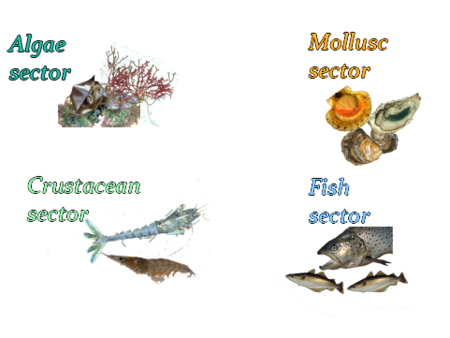Scallops
Name : | Common scallop |
|---|---|
Scientific name : | Pecten maximus |
Size : | This species can grow to a size of 17 cm. The minimum marketable size is 10 cm (legal European size), but the minimum fishable size can be larger (10.5 to 11 cm) depending on the scallop bed. |
History
Common scallop aquaculture is closely linked with fishing (restocking and management of common scallop beds ). However, this aquaculture activity now only concerns the Brest Basin bed. At present production levels, it is only possible to supplement other small scallop beds with yields of a few hundred tons. Some trials take actually place around St Malo and Belle-Ile.
The common scallop population in the Brest Basin markedly declined after the harsh winter of 1962-63. A restocking program was thus planned. The first trials on setting wild spat on collectors were not very successful, so in 1983 a decision was made to develop a production sector based on nursery spat production.
Culture techniques and production cycle : from spat aquaculture to fishing adults
There are three phases in the common scallop culture cycle:
|
|
|
|
|
Young scallops seeded at 1 year old (30 mm) are harvested 2-3 years later, at the same time as natural common scallops whose populations they now belong to. This cycle applies to all natural scallop beds that can be legally fished or in grounds prohibited for fishing during the scallop growth period. |
Pecten jacobeus, another very similar species, is found in the Mediterranean.
Many other pectinids species are bred (on ground or in suspension) all around the world (China, Japan, New Zealand...)
Common scallop production
In the late 1950s, 2500 tons of common scallops were fished in the Brest Basin.
This annual yield was reduced to some hundred tons after 1963.
The result of Aquaculture program was perceptible in 1990 and, at present, two out of three scallops fished issue from seeding.
20 million post-larva had to be hatchery reared to yield the 200 tons of common scallops that were fished after seeding in 2002-2003
Product value enhancement (seed scallops)
Common scallops, like other fished shellfish, are mainly sold fresh and consumed cooked. This strategy is facilitated by the fact that common scallops can be readily managed to meet the high demand during certain periods (especially Christmas) and to offer larger individuals derived from temporarily prohibited fishing grounds—thus further enhancing the market potential of these products.
Common scallop figures
70 | fishing licenses allocated for common scallop seeding in the Brest Basin. |
|---|---|
1 | nursery producing common scallop spat |
200 | tons of common scallops fished that are derived from hatchery reared spat |
A substantial increase in spat production would now be required to further develop this sector.
Strengths / Weaknesses
Strengths | Weaknesses |
|---|---|
|
|

